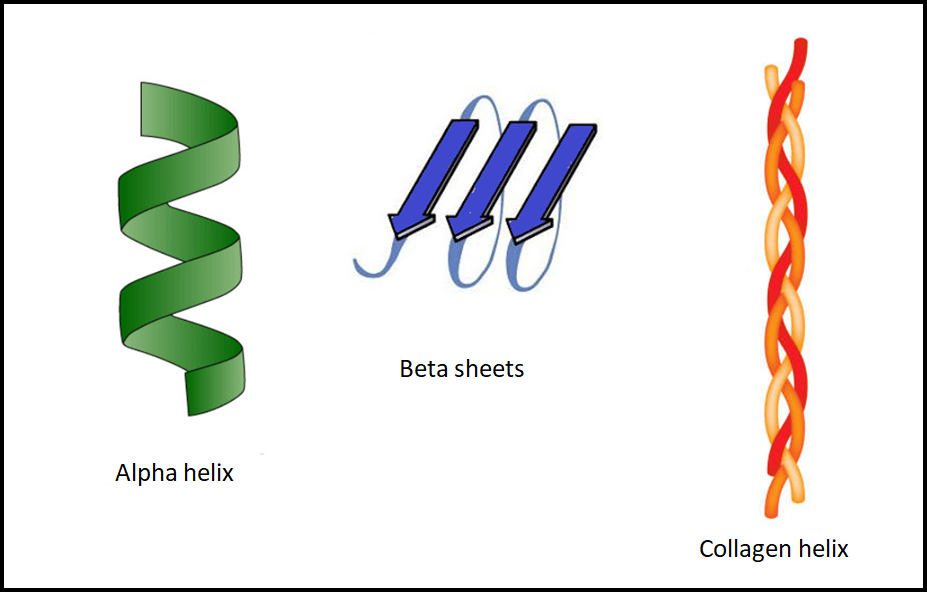
Which of these is a type of protein secondary structure?
(a) α-helix
(b) β-pleated
(c)Collagen helix
(d)All of the above
Answer
573.6k+ views
Hint: The three-dimensional form of protein segments is known as protein secondary structure and it acts as an intermediate spontaneous form before the protein turns into a tertiary structure.
Complete answer:
Two common protein secondary structures are alpha helix and beta sheets. Even the collagen helix is a secondary structure. `The secondary structure has regions of stabilized hydrogen bonds between atoms in the polypeptide backbone.
The alpha helix being one of the secondary structure proteins is formed within a polypeptide chain because of the emergence of hydrogen bonds between backbone amide and carbonyl groups. This right hand- helix is formed by the N-H group being the backbone of hydrogen bonds and the C=O group of another amino acid situated three or four residues earlier along the protein sequence. It has 3.6 amino acid residues per turn; this means that an alpha-helix of 10 turns has 36 amino acids.
The beta-sheet has beta strands connected parallel or antiparallel polypeptide chains linked together by H- bonds and forms a general twisted pleated sheet. The successive side chains point straight up, then down and again up, this continues. The beta-strand has 3 to 10 amino acids with a polypeptide chain along the backbone in an extended conformation.
Collagen or type-2 helix is a fibrous protein and consists of the triple helix that is made of repeating glycine-X and glycine-Y amino acid sequence. X and Y are usually proline or hydroxyproline. It is more stretched or elongated compared to the alpha-helix and is a left-handed helix.
So, the correct answer is ‘All of the above’.
Note: Fibrous proteins like collagens are polypeptide chains that are stretched and fibrous in nature. They may even have a sheet-like structure. These sheets are mechanically strong and insoluble in water. They are structural proteins and provide strength and support to the cells and tissue. Other examples of fibrous proteins are keratins, myosins, and elastins.

Complete answer:
Two common protein secondary structures are alpha helix and beta sheets. Even the collagen helix is a secondary structure. `The secondary structure has regions of stabilized hydrogen bonds between atoms in the polypeptide backbone.
The alpha helix being one of the secondary structure proteins is formed within a polypeptide chain because of the emergence of hydrogen bonds between backbone amide and carbonyl groups. This right hand- helix is formed by the N-H group being the backbone of hydrogen bonds and the C=O group of another amino acid situated three or four residues earlier along the protein sequence. It has 3.6 amino acid residues per turn; this means that an alpha-helix of 10 turns has 36 amino acids.
The beta-sheet has beta strands connected parallel or antiparallel polypeptide chains linked together by H- bonds and forms a general twisted pleated sheet. The successive side chains point straight up, then down and again up, this continues. The beta-strand has 3 to 10 amino acids with a polypeptide chain along the backbone in an extended conformation.
Collagen or type-2 helix is a fibrous protein and consists of the triple helix that is made of repeating glycine-X and glycine-Y amino acid sequence. X and Y are usually proline or hydroxyproline. It is more stretched or elongated compared to the alpha-helix and is a left-handed helix.
So, the correct answer is ‘All of the above’.
Note: Fibrous proteins like collagens are polypeptide chains that are stretched and fibrous in nature. They may even have a sheet-like structure. These sheets are mechanically strong and insoluble in water. They are structural proteins and provide strength and support to the cells and tissue. Other examples of fibrous proteins are keratins, myosins, and elastins.

Recently Updated Pages
Master Class 12 Business Studies: Engaging Questions & Answers for Success

Master Class 12 Economics: Engaging Questions & Answers for Success

Master Class 12 English: Engaging Questions & Answers for Success

Master Class 12 Maths: Engaging Questions & Answers for Success

Master Class 12 Social Science: Engaging Questions & Answers for Success

Master Class 12 Chemistry: Engaging Questions & Answers for Success

Trending doubts
What is meant by exothermic and endothermic reactions class 11 chemistry CBSE

Which animal has three hearts class 11 biology CBSE

10 examples of friction in our daily life

One Metric ton is equal to kg A 10000 B 1000 C 100 class 11 physics CBSE

1 Quintal is equal to a 110 kg b 10 kg c 100kg d 1000 class 11 physics CBSE

Difference Between Prokaryotic Cells and Eukaryotic Cells




